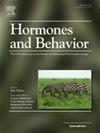Are women's sexual preferences for men's facial hair associated with their testosterone during the menstrual cycle?
IF 2.4
3区 医学
Q2 BEHAVIORAL SCIENCES
引用次数: 0
Abstract
The ovulatory shift hypothesis proposes that women's mate preferences for androgen-dependent secondary sexual traits in men are most pronounced during the ovulatory phase of the menstrual cycle. Using an appropriately powered within-subjects design, we provide the first test of whether women's sexual preferences for male facial hair, which is reliably associated with male sexual maturity and masculinity, peak during the ovulatory phase among women with higher salivary testosterone. Sixty-five heterosexual women completed the study, which included a two-alternative forced choice preference test wherein participants selected the face they found most sexually attractive from pairs of composite images of the same men when fully bearded and when clean-shaven. The task was completed among the same participants during the follicular, ovulatory (validated by the surge in luteinizing hormone) and luteal phases. Participants also provided saliva samples for subsequent assaying of testosterone. We ran two models, both of which showed strong preferences among women for bearded over clean-shaven composite faces. In our first model, women's preferences for bearded faces were negatively associated with their salivary testosterone levels. In our second model, in which we included women's menstrual cycle phase, this negative association appeared to be driven by preferences among women in the ovulatory and follicular phases. However, the main effect of cycle phase and the interaction between testosterone and cycle phase were not statistically significant. Although further replication is required to confirm our findings, for the present we conclude that women's preferences for men's beardedness may not be related to changes in their salivary testosterone over the menstrual cycle in ways that support the ovulatory shift hypothesis.
女性对男性面部毛发的性偏好是否与月经周期中的睾丸激素有关?
排卵转移假说认为,女性对男性雄激素依赖性第二性征的择偶偏好在月经周期的排卵期最为明显。使用适当的受试者内设计,我们提供了第一个测试,以确定女性对男性面部毛发的性偏好是否在唾液睾酮水平较高的女性排卵期达到顶峰。面部毛发与男性性成熟和男子气概有关。65名异性恋女性完成了这项研究,其中包括一项两种选择的强迫选择偏好测试,参与者从同一名男性的两组合成照片中选择他们认为最具性吸引力的一张,这些照片是留胡子的和刮干净的。这项任务是在卵泡期、排卵期(通过黄体生成素的激增来验证)和黄体期完成的。参与者还提供了唾液样本,用于随后的睾酮检测。我们运行了两个模型,这两个模型都显示,女性更喜欢留胡子的脸,而不是刮得干干净净的复合型脸。在我们的第一个模型中,女性对大胡子面孔的偏好与她们的唾液睾酮水平呈负相关。在我们的第二个模型中,我们纳入了女性的月经周期阶段,这种负相关似乎是由女性在排卵期和卵泡期的偏好所驱动的。然而,周期的主要影响以及睾酮与周期的相互作用无统计学意义。虽然需要进一步的复制来证实我们的发现,但目前我们得出的结论是,女性对男性留胡子的偏好可能与月经周期中唾液睾酮的变化无关,这支持了排卵转移假说。
本文章由计算机程序翻译,如有差异,请以英文原文为准。
求助全文
约1分钟内获得全文
求助全文
来源期刊

Hormones and Behavior
医学-行为科学
CiteScore
6.70
自引率
8.60%
发文量
139
审稿时长
91 days
期刊介绍:
Hormones and Behavior publishes original research articles, reviews and special issues concerning hormone-brain-behavior relationships, broadly defined. The journal''s scope ranges from laboratory and field studies concerning neuroendocrine as well as endocrine mechanisms controlling the development or adult expression of behavior to studies concerning the environmental control and evolutionary significance of hormone-behavior relationships. The journal welcomes studies conducted on species ranging from invertebrates to mammals, including humans.
 求助内容:
求助内容: 应助结果提醒方式:
应助结果提醒方式:


